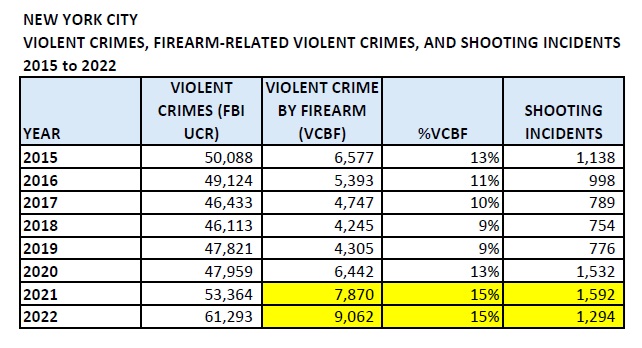Every county in New York State, except for the five that make up New York City, has submitted data on Violent Crime by Firearm (VCBF) for 2023. The NYPD has stopped reporting violent crimes involving firearms in 2023, despite consistently reporting shooting incidents and confiscated firearms. The lack of VCBF data from NYC Mayor Eric Adams’ administration obstructs a comprehensive grasp of gun violence within both New York City and the broader New York State.
New York City uses stringent criteria to classify shootings, only recognizing incidents where an individual is actually hit by a bullet. Shootings where the target is missed are not included in the city’s statistics. This approach does not reflect the actual number of firearms used in violent crimes. The New York State Division of Criminal Justice Services reported a 22.2% increase in violent crimes involving firearms in 2021, with 7,870 incidents up from 6,442 in 2020. In 2022, violent crimes rose by 15.1% to 9,062 from the 7,870 incidents in 2021, indicating a divergence in the trends of firearm-related violent crimes and shootings.
 Note: Violent crimes in New York State are categorized as murder, rape, robbery, and aggravated assault, adhering to the definitions set by the FBI’s Uniform Crime Report (UCR). However, New York City employs a classification for rape and aggravated assaults that corresponds with the definitions from the New York State Penal Law (NYSPL), which are stricter than those of the FBI’s UCR. The numbers for violent crimes presented in the chart above follow the FBI UCR standards.
Note: Violent crimes in New York State are categorized as murder, rape, robbery, and aggravated assault, adhering to the definitions set by the FBI’s Uniform Crime Report (UCR). However, New York City employs a classification for rape and aggravated assaults that corresponds with the definitions from the New York State Penal Law (NYSPL), which are stricter than those of the FBI’s UCR. The numbers for violent crimes presented in the chart above follow the FBI UCR standards.
In summary, New York City’s omission in reporting firearm-related crime data significantly hinders the understanding of gun violence’s full impact. The strict standards NYC applies to categorize shootings, along with the absence of detailed data on violent crimes involving guns, conceal the actual magnitude of gun-related violence. Such discrepancies impede effective gun violence mitigation strategies and underscore the necessity for uniform reporting methods across jurisdictions to provide a clearer and more comprehensive perspective on the problem.
Written by,
Sam Antar
© Copyright by Sam Antar. All rights reserved.